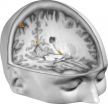(Press-News.org) Neuroscientists have perfected a chemical-genetic remote control for brain circuitry and behavior. This evolving technology can now sequentially switch the same neurons - and the behaviors they mediate - on-and-off in mice, say researchers funded by the National Institutes of Health. Such bidirectional control is pivotal for decoding the brain workings of complex behaviors. The findings are the first to be published from the first wave of NIH grants awarded last fall under the BRAIN Initiative.
"With its new push-pull control, this tool sharpens the cutting edge of research aimed at improving our understanding of brain circuit disorders, such as schizophrenia and addictive behaviors," said NIH director Francis S. Collins, M.D., Ph.D.
Bryan Roth, M.D., Ph.D., of the University of North Carolina, Chapel Hill; Michael Krashes, Ph.D., of NIH's National Institute of Diabetes and Digestive and Kidney Diseases; and colleagues, debut the second generation of the tool, called DREADD - Designer Receptors Exclusively Activated by Designer Drugs - on April 30, 2014 in the journal Neuron.
DREADD 2.0 improves on a widely-adopted technology developed by Roth, a grantee of NIH's National Institute of Mental Health, and colleagues, over the past decade. It achieves remote control by introducing a synthetic brain chemical messenger system that integrates with the workings of naturally-occurring systems.
Researchers genetically-engineer mice to have brains containing what they dub "designer receptors" in specific circuits. These are synthetic proteins on the surface of neurons that can only be activated by a matching synthetic chemical that otherwise has no biological effect - like a lock that can only be opened by a unique key. When the "designer drug" binds to its receptor, depending on its programming, it either triggers or blocks neuronal activity, thus giving researchers experimental control over the animal's brain circuits and behaviors.
Early iterations of DREADD could only control activity in one direction - on or off - in the same population of cells. DREADD 2.0 takes advantage of properties offered by a particular type of receptor, paired with a biologically inert chemical that binds to it, to add bidirectional control. Coupled with an existing DREADD, it can be used experimentally to probe circuitry of a broad range of behaviors via sequential, on-and-off control of neurons. It's like having two sets of locks with their own unique keys - one triggering "on," the other turning "off." For example, the researchers demonstrated how the improved DREAD toolkit can bi-directionally control animals' movement and feeding behaviors.
Since DREADD effects last about an hour - as opposed to milliseconds with an alternative optical-genetic technology - it may be the tool of choice for studies of behaviors requiring prolonged control of circuitry and/or minimal invasiveness.
INFORMATION:
Reference: Vardy E, Robinson JE, Li C, Olsen RHJ, DiBerto JF, Giguere PM, Sassano FM, Huang X-P, Zhu H, Urban DJ, White KL, Rittiner JE, Crowley NA, Pleil KE, Mazzone CM Mosier PD, Song J, Kash TL, Malanga CJ, Krashes MJ, Roth BL. A new DREADD facilitates the multiplexed chemogenetic interrogation of behavior. Neuron, April 30, 2015.
The mission of the NIMH is to transform the understanding and treatment of mental illnesses through basic and clinical research, paving the way for prevention, recovery and cure. For more information, visit the http://www.nimh.nih.gov.
The National Institute on Drug Abuse is a component of the National Institutes of Health, U.S. Department of Health and Human Services. NIDA supports most of the world's research on the health aspects of drug abuse and addiction. The Institute carries out a large variety of programs to inform policy and improve practice. Fact sheets on the health effects of drugs of abuse and information on NIDA research and other activities can be found at http://www.drugabuse.gov, which is now compatible with your smartphone, iPad or tablet. To order publications in English or Spanish, call NIDA's DrugPubs research dissemination center at 1-877-NIDA-NIH or 240-645-0228 (TDD) or email requests to drugpubs@nida.nih.gov. Online ordering is available at http://drugpubs.drugabuse.gov. NIDA's media guide can be found at http://www.drugabuse.gov/publications/media-guide/dear-journalist, and its easy-to-read website can be found athttp://www.easyread.drugabuse.gov.
The NIDDK, a component of the NIH, conducts and supports research on diabetes and other endocrine and metabolic diseases; digestive diseases, nutrition and obesity; and kidney, urologic and hematologic diseases. Spanning the full spectrum of medicine and afflicting people of all ages and ethnic groups, these diseases encompass some of the most common, severe and disabling conditions affecting Americans. For more information about the NIDDK and its programs, see http://www.niddk.nih.gov.
The National Institute on Alcohol Abuse and Alcoholism, part of the National Institutes of Health, is the primary U.S. agency for conducting and supporting research on the causes, consequences, prevention, and treatment of alcohol abuse, alcoholism, and alcohol problems. NIAAA also disseminates research findings to general, professional, and academic audiences. Additional alcohol research information and publications are available at http://www.niaaa.nih.gov.
About the National Institutes of Health (NIH): NIH, the nation's medical research agency, includes 27 Institutes and Centers and is a component of the U.S. Department of Health and Human Services. NIH is the primary federal agency conducting and supporting basic, clinical, and translational medical research, and is investigating the causes, treatments, and cures for both common and rare diseases. For more information about NIH and its programs, visit the http://www.nih.gov.
The feeling of being inside one's own body is not as self-evident as one might think. In a new study from Sweden's Karolinska Institutet, neuroscientists created an out-of-body illusion in participants placed inside a brain scanner. They then used the illusion to perceptually 'teleport' the participants to different locations in a room and show that the perceived location of the bodily self can be decoded from activity patterns in specific brain regions.
The sense of owning one's body and being located somewhere in space is so fundamental that we usually take it for granted. ...
First study to show pattern of telomere changes at multiple time points as cancer develops
Telomeres can look 15 years older in people developing cancer
Pattern suggests when cancer hijacks the cell's aging process
CHICAGO -- A distinct pattern in the changing length of blood telomeres, the protective end caps on our DNA strands, can predict cancer many years before actual diagnosis, according to a new study from Northwestern Medicine in collaboration with Harvard University.
The pattern -- a rapid shortening followed by a stabilization three or four years before ...
Rochester, Minn. -- Over the last decade, numerous studies have shown that many Americans have low vitamin D levels and as a result, vitamin D supplement use has climbed in recent years. Vitamin D has been shown to boost bone health and it may play a role in preventing diabetes, cancer, cardiovascular disease and other illnesses. In light of the increased use of vitamin D supplements, Mayo Clinic researchers set out to learn more about the health of those with high vitamin D levels. They found that toxic levels are actually rare.
Their study appears in the May issue of ...
LA JOLLA--Stem cells, which have the potential to turn into any kind of cell, offer the tantalizing possibility of generating new tissues for organ replacements, stroke victims and patients of many other diseases. Now, scientists at the Salk Institute have uncovered details about stem cell growth that could help improve regenerative therapies.
While it was known that two key cellular processes--called Wnt and Activin--were needed for stem cells to grow into specific mature cells, no one knew exactly how these pathways worked together. The details of how Wnt and Activin ...
Many human communities want answers about the current status and future of Arctic marine mammals, including scientists who dedicate their lives to study them and indigenous people whose traditional ways of subsistence are intertwined with the fate of species such as ice seals, narwhals, walruses and polar bears.
But there are many unknowns about the current status of 11 species of marine mammals who depend on Arctic sea ice to live, feed and breed, and about how their fragile habitat will evolve in a warming world.
A recently published multinational study attempted ...
AUSTIN, Minn. (4/30/15) - Taking aspirin reduces a person's risk of colorectal cancer, but the molecular mechanisms involved have remained unknown until a recent discovery by The Hormel Institute, University of Minnesota.
Researchers led by The Hormel Institute's Executive Director Dr. Zigang Dong and Associate Director Dr. Ann M. Bode, who co-lead the Cellular & Molecular Biology section, discovered that aspirin might exert its chemopreventive activity against colorectal cancer, at least partially, by normalizing the expression of epidermal growth factor receptor (EGFR) ...
New York, NY (April 30, 2015) - The use of integrative medicine interventions leads to significant improvements in patient activation and patient-reported outcomes in the treatment of chronic pain, depression, and stress, according to a new report released by The Bravewell Collaborative. The findings are based on data collected by the Patients Receiving Integrative Medicine Interventions Effectiveness Registry (PRIMIER), the first-ever patient registry on integrative medicine.
"We are encouraged by these early results, and we see tremendous potential for PRIMIER to provide ...
Philadelphia, April 30, 2015 -- The American College of Physicians (ACP) today released clinical advice aimed at reducing overuse of cervical cancer screening in average risk women without symptoms. "Cervical Cancer Screening in Average Risk Women" is published in Annals of Internal Medicine and lists two concurring organizations: the American Congress of Obstetricians and Gynecologists and the American Society for Clinical Pathology.
"ACP's advice for cervical cancer screening is designed to maximize the benefits and minimize the harms of testing," said Dr. David Fleming, ...
1. American College of Physicians releases Best Practice Advice for the proper time, test, and interval for cervical cancer screening
ACP's advice is supported by ACOG and endorsed by ASCP
New clinical advice from the American College of Physicians (ACP) aims to reduce overuse of cervical cancer screening in average risk women without symptoms. "Cervical Cancer Screening in Average Risk Women" is published in Annals of Internal Medicine and lists two concurring organizations: the American Congress of Obstetricians and Gynecologists and the American Society for Clinical ...
HOUSTON - (April 30, 2015) - The percentage of Texans without health insurance dropped 31 percent since enrollment began in the Affordable Care Act's (ACA) Health Insurance Marketplace, according to a new report released today by the Episcopal Health Foundation and Rice University's Baker Institute for Public Policy.
The report found that from September 2013 to March 2015, the percentage of uninsured adult Texans ages 18-64 dropped from 25 to 17 percent.
"This is a dramatic drop that's unprecedented in Texas," said Elena Marks, president and CEO of the Episcopal Health ...


